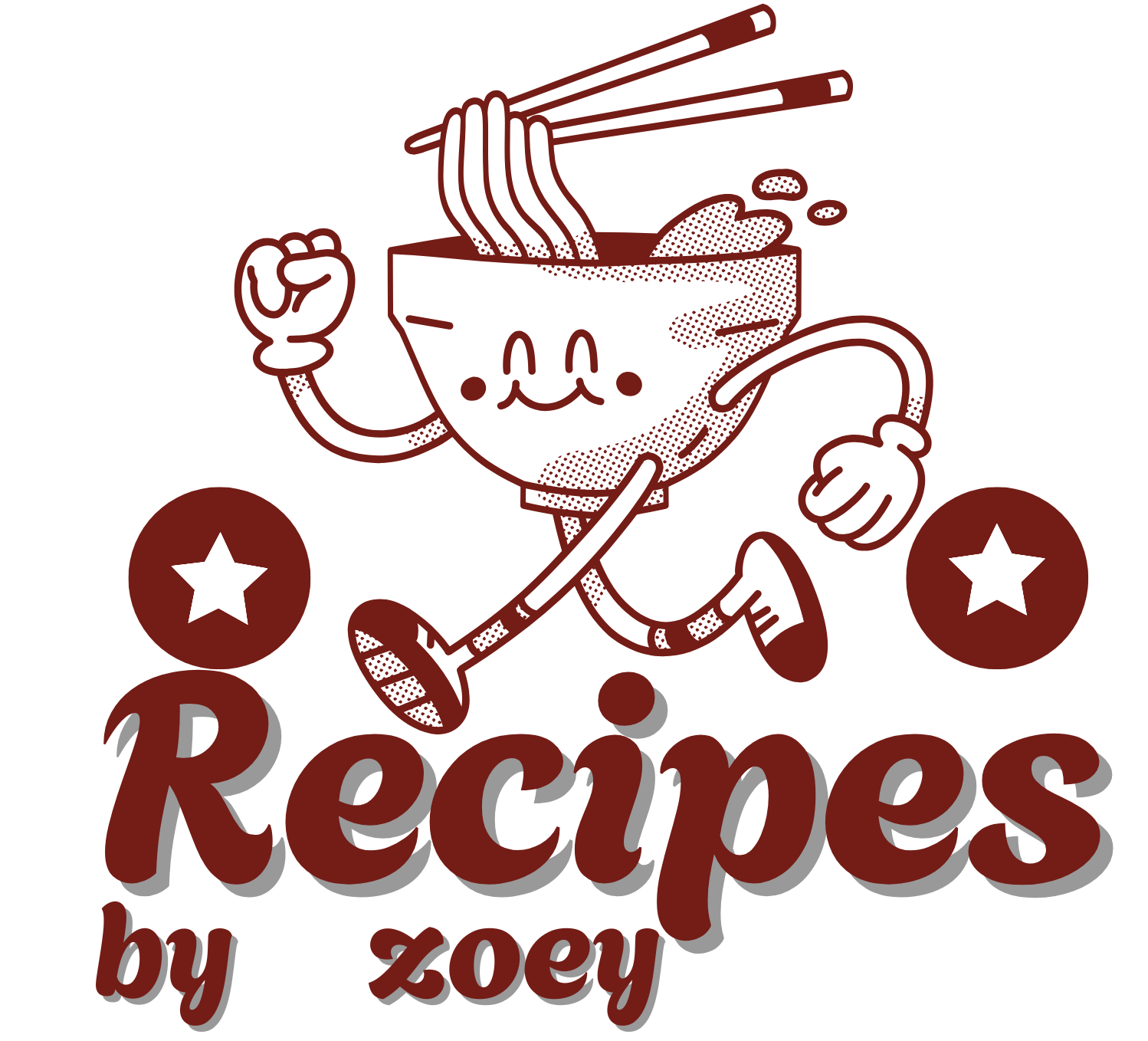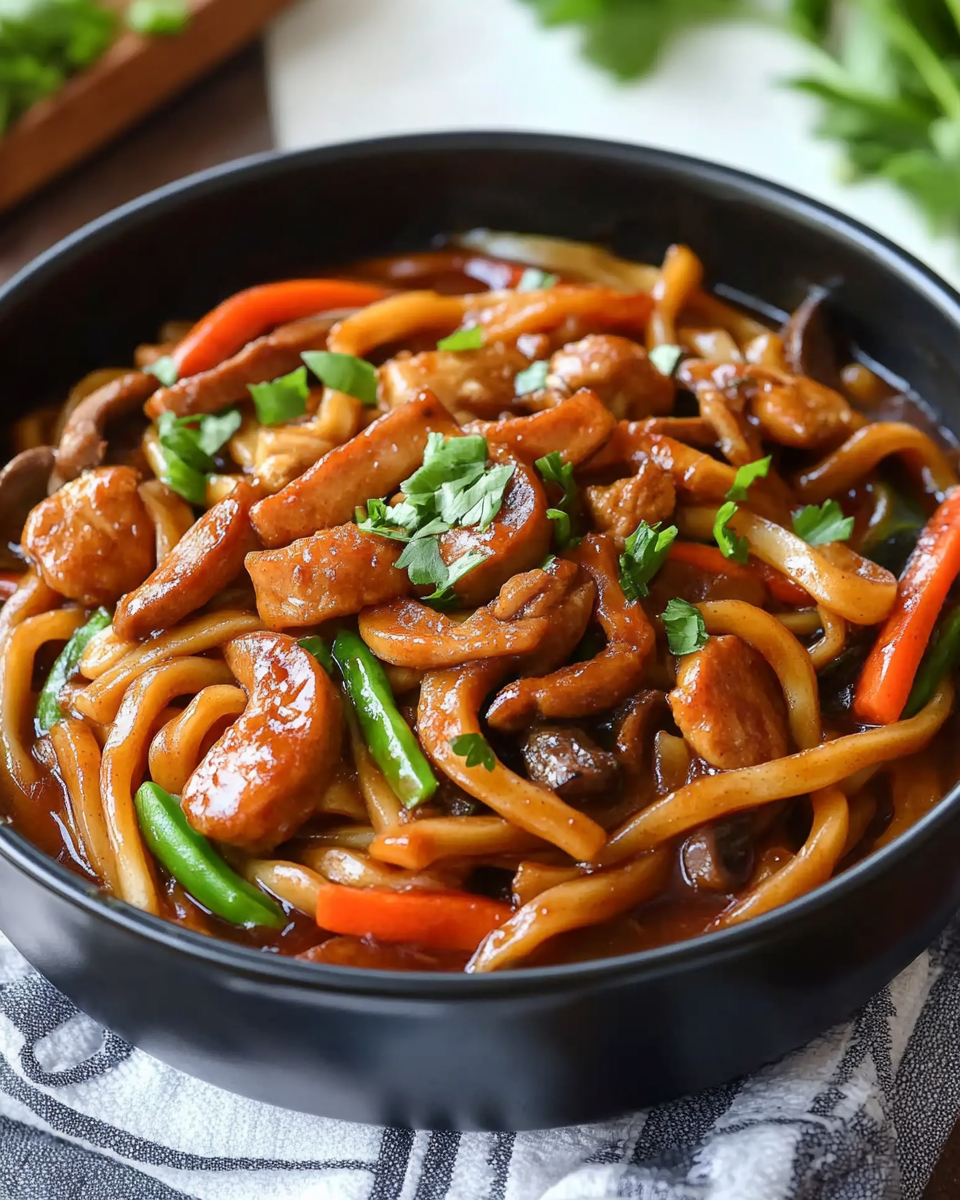Yaki Udon is a delicious and quick Japanese stir-fry featuring chewy udon noodles, vegetables, and protein, all coated in a savory sweet sauce. This 15-minute meal is perfect for busy weeknights and can be customized with your favorite protein like pork, chicken, shrimp, or tofu. The bouncy texture of udon paired with the rich, flavorful sauce makes this dish an irresistible favorite!
Full Recipe:
Ingredients
-
For the noodles and stir-fry:
-
1 lb udon noodles (frozen or fresh)
-
1/2 lb pork belly (or substitute with chicken, shrimp, pork, or steak)
-
1 cup cabbage, thinly sliced
-
3/4 cup mushrooms, sliced
-
1/2 cup carrots, julienned
-
1/2 onion, julienned
-
1 green onion, finely chopped
-
2 cloves garlic, minced
-
1 tbsp vegetable oil (or any neutral oil)
-
-
For the sauce:
-
1 tbsp dark soy sauce
-
1 tbsp regular soy sauce
-
1 tbsp oyster sauce
-
1 tbsp mirin
-
1 tbsp rice vinegar
-
2 tsp white granulated sugar
-
Directions
-
Prepare the sauce: In a small bowl, combine all sauce ingredients and set aside.
-
Soak the noodles: In a large bowl, soak udon noodles in boiling water for 30-45 seconds until loosened. Strain and set aside.
-
Cook the protein: Heat oil in a large pan over medium-high heat. Fry pork belly (or your choice of protein) until golden brown and the fat has rendered out, about 2-3 minutes. Remove from the pan and set aside.
-
Stir-fry the vegetables: In the same pan, reduce heat to medium and stir-fry garlic and onions until translucent, about 30 seconds. Add cabbage, mushrooms, and carrots, cooking until softened.
-
Combine the noodles and sauce: Toss in the cooked noodles, sauce, and protein. Stir until the noodles are evenly coated in the sauce.
-
Serve: Garnish with chopped green onions and serve hot.
Nutrients (per serving, for 2 servings)
-
Calories: 1462 kcal
-
Carbohydrates: 172g
-
Protein: 49g
-
Fat: 67g
-
Saturated Fat: 22g
-
Cholesterol: 82mg
-
Sodium: 4107mg
-
Potassium: 602mg
-
Fiber: 15g
-
Sugar: 32g
-
Vitamin A: 5530 IU
-
Vitamin C: 20mg
-
Calcium: 55mg
-
Iron: 2mg
The Allure of Udon Noodles
At the heart of Yaki Udon is the udon noodle. Udon is a thick, chewy Japanese noodle made from wheat flour, and its satisfying texture makes it perfect for stir-fries. The noodles provide a substantial bite that pairs beautifully with a variety of proteins and vegetables, absorbing the flavors of the sauce while still holding up to the heat of stir-frying. Their bouncy, firm texture offers a unique contrast to the other elements of the dish, making each bite both hearty and satisfying.
Udon noodles are available in fresh, frozen, or dried varieties, all of which work well for Yaki Udon. If you’re using fresh or frozen udon, simply soak them briefly in hot water to loosen them before stir-frying. This makes them easy to work with and ensures they absorb the sauce more effectively. Dried udon noodles, on the other hand, require a longer cooking time but will also yield deliciously chewy results when properly cooked and soaked.
The Versatility of Protein Choices
One of the best aspects of Yaki Udon is its flexibility when it comes to protein. While the traditional version often uses pork belly, you can easily swap in other proteins based on your preferences or dietary restrictions. Pork belly offers a rich, juicy texture, and the fat adds depth to the dish, but leaner options like chicken breast or shrimp provide a lighter alternative. For a vegetarian or vegan option, tofu can be used as the protein, and its ability to soak up the sauce ensures a flavorful bite in every piece.
Whatever protein you choose, it should be cooked until golden brown and slightly crispy on the outside. This ensures that the protein retains its flavor and texture during the stir-frying process, providing a satisfying contrast to the soft noodles and tender vegetables.
A Savory-Sweet Sauce That Ties It All Together
The secret to a great Yaki Udon is in the sauce. The combination of dark soy sauce, regular soy sauce, oyster sauce, mirin, rice vinegar, and a touch of sugar creates a perfect balance of salty, sweet, and umami flavors. The soy sauce provides a deep, savory base, while the oyster sauce adds richness and a subtle seafood essence that elevates the dish. Mirin, a sweet rice wine, imparts a light sweetness and helps to round out the flavors, while the rice vinegar adds just the right amount of tang to balance the richness.
The sauce is thickened slightly with the help of the noodles and the cooking process, giving it a glossy finish that coats the noodles beautifully. As the noodles absorb the sauce, they take on its rich flavor, making every bite a delightful mix of savory and sweet. You can adjust the sweetness and saltiness of the sauce to your preference by tweaking the amount of sugar, soy sauce, and mirin used.
The Vegetables: Fresh and Flavorful Additions
A well-balanced Yaki Udon stir-fry includes a variety of vegetables, adding freshness, texture, and color to the dish. In this recipe, cabbage, mushrooms, carrots, and onions are commonly used. The cabbage adds crunch and sweetness, while the mushrooms bring an earthy depth to the dish. The carrots, julienned for a delicate texture, provide a bit of sweetness and bright color, and the onions contribute a mild, savory flavor.
The vegetables should be stir-fried until they’re tender but still have some bite, which keeps them vibrant and adds a satisfying crunch when combined with the soft noodles. If you like, you can experiment with other vegetables, such as bell peppers, spinach, or bok choy, depending on what’s in season or what you have in your kitchen.
A 15-Minute Meal: Perfect for Busy Weeknights
What makes Yaki Udon especially appealing is its speed. From start to finish, this dish can be ready in just 15 minutes, making it an ideal meal for busy weeknights or when you want something comforting without spending too much time in the kitchen. The whole dish is cooked in a single pan, meaning fewer dishes to clean afterward—always a bonus when preparing dinner in a rush.
Once you’ve prepped your ingredients, the cooking process is simple. The protein is quickly cooked in hot oil until browned, then removed from the pan. In the same pan, garlic and onions are sautéed, followed by the rest of the vegetables. After the vegetables soften, the noodles and sauce are added to the pan, and everything is tossed together until the noodles are evenly coated in the flavorful sauce. With the protein added back in, the dish is ready to serve, garnished with chopped green onions for a burst of freshness.
Customizing Yaki Udon to Your Taste
One of the best things about Yaki Udon is its flexibility. You can easily adjust the recipe based on your personal taste or dietary needs. Want a spicier version? Add a little chili paste or a dash of hot sauce to the sauce mixture. Prefer more vegetables? Feel free to add more cabbage, mushrooms, or any other vegetable you enjoy.
For those who are gluten-sensitive, you can use gluten-free soy sauce and choose a gluten-free noodle alternative. Udon noodles are traditionally made with wheat flour, but there are gluten-free udon noodles available that still provide a satisfying texture.
Additionally, Yaki Udon can be made as vegetarian or vegan by replacing the meat with tofu or tempeh and ensuring that the sauces used are free of animal products. By swapping out the traditional oyster sauce with a vegetarian oyster sauce or a mushroom-based alternative, you can maintain the rich flavor profile while keeping the dish plant-based.
Nutritional Considerations
While Yaki Udon is a hearty and satisfying meal, it’s important to be mindful of its nutritional content. The dish is relatively high in carbohydrates due to the udon noodles, so it’s best enjoyed in moderation if you’re watching your carb intake. The vegetables add fiber, vitamins, and minerals, while the protein provides a good source of sustenance.
Depending on the protein you choose, the fat content can vary. For example, using lean chicken breast instead of pork belly will lower the fat content, while tofu offers a plant-based protein with healthy fats. As with all stir-fries, using a moderate amount of oil will help keep the dish flavorful without being too heavy.
Conclusion: A Flavorful and Satisfying Meal
Yaki Udon is a perfect example of a quick, delicious, and versatile meal. The chewy noodles, savory sauce, and choice of protein create a flavorful dish that’s sure to satisfy. With the ability to customize the ingredients based on your preferences and dietary needs, this 15-minute meal is perfect for anyone looking for a hearty, comforting dish that doesn’t take hours to prepare. Whether you’re craving something traditional or want to experiment with new flavors, Yaki Udon is a dish that will quickly become a staple in your recipe collection.

